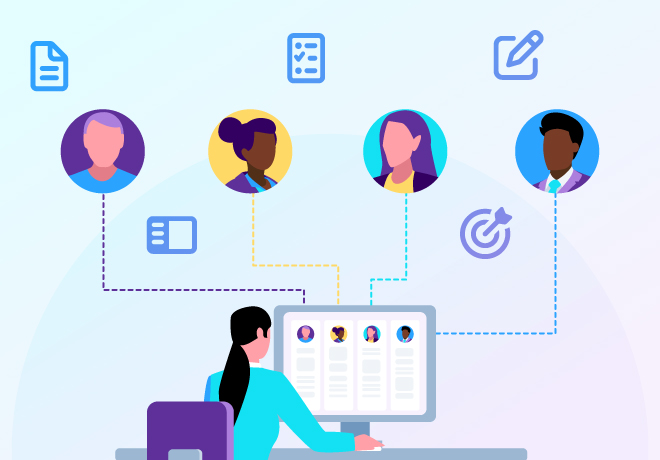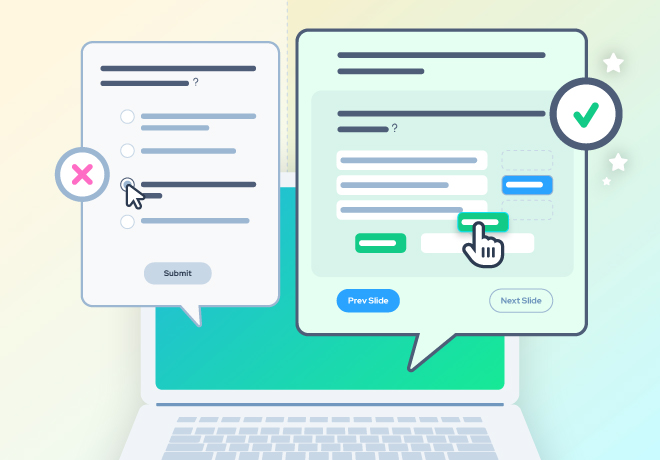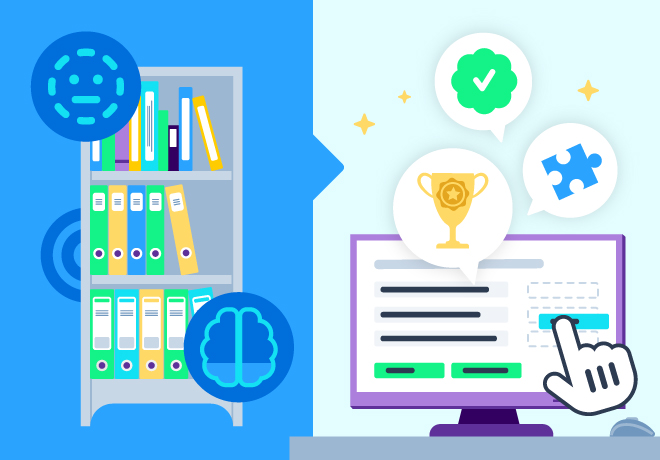
What is game-based learning?

Related articles
Get valuable eLearning insights to your inbox.
Listen to Neovation’s Demystifying eLearning podcast generated with NotebookLM!
Listen to our podcast on your favorite platform!
Game-based learning is often conflated with gamification.
But, though they may share goals, the terms describe different approaches:
- Game-based learning is an approach to creating learning content in the form of a game. These learning games or “serious games” are designed to modify behavior, teach content or solve a problem. They use elements of games, such as competition against others or oneself, a set of rules and the use of rewards and penalties to encourage play and measure progress and mastery.
- Gamification, on the other hand, adds game elements to learning content with the goal of making learning fun and engaging, appealing to learners’ sense of competition or motivating learners to spend more time on training. It might turn the entire learning exercise into a Jeopardy-like game, for example, or stay simple — awarding points or badges each time a learner completes a chapter of a training module.
The distinction between gamification and game-based learning might boil down to a chicken-and-egg argument: If the content exists, and game elements are added, you have gamified the content. If you are creating a new piece of training content and building it as a game, it is game-based learning.
Let’s examine game-based learning and the differences between it and gamification. A related article, “What is Gamification?” offers a deeper treatment of gamification in learning.
How is game-based learning different from gamification?
Gamified learning and game-based learning share the goals of driving motivation, increasing learner engagement and promoting learning, but there are significant differences in the design and development of these types of learning content.
Learning technology expert Karl Kapp explained that “serious games use game techniques to address a ‘serious’ subject” and gamification “applies game thinking outside of a game” or takes non-game objects or content and turns them into a game.
Game-based learning integrates the game with the content
Game-based learning builds a game challenge around mastering and applying specific instructional content. From the beginning of the instructional design process, a serious learning game is integrated with the learning content. It would not be possible to pull the content out and swap different learning content into the game “shell” or framework.
Oft-cited examples include McDonald’s Till Training game and the Domino’s Pizza Hero game. These re-create workplace scenarios, whether the McDonald’s cashier station or the pizza assembly space at Domino’s, in a game format. Players learn skills that they will use on the job, practicing to improve their speed, reduce errors and learn the specific processes they are expected to follow at work.

In these examples, the content and the game are inseparable. Elements of game play, such as racing against the clock, competing to beat other players’ time or earning points or badges may also be built into the game.
Serious games can tackle multilayered or complex challenges as well, aiming to deepen and measure mastery of learning content by asking learners to use the instructional content to solve problems and meet goals baked into the game. Serious games have been developed to educate players on health issues, deforestation, oil consumption, HIV prevention and much more. Within a corporate environment, specific content, whether on preventing harassment, understanding banking regulations or building leadership skills, can be built into a serious learning game.
Examples include:
- An immersive simulation allows learners to encounter patients in a virtual hospital emergency room, diagnose the patients’ problems and recommend treatment.
- Learners travel through a virtual world, earning passport “stamps” as they correctly solve problems and answer questions on travel expense policies.
- Learners compete to correctly solve challenges on a virtual “scavenger hunt” that reveals tools and assistance when they correctly answer questions on banking regulations.
Gamification adds layers to learning content
Gamified learning layers game elements, like points or badges, or adds interactive tasks, like matching or a maze, on top of existing instructional content.
- Gamification may turn learning content into a game: Presenting content-based questions in a gameshow format or using them as clues to a crossword puzzle, for example.
- Alternatively, the game elements might simply enhance existing eLearning without actually turning it into a game: Awarding points or badges when learners complete a unit of training, say, or challenging learners to beat their own past performance in a skills drill or in matching features to new products.
Gamifying learning aims to increase the amount of time learners spend with the training content, with the idea that learners who spend more time training will remember the material longer. Apps like Duolingo illustrate how gamification can help learners stick with training even for a long-term, complex learning project like learning a foreign language. And wearables like FitBits and smart watches gamify health and fitness, challenging people to walk more each day or get their heart rate into a target range for 3 minutes while exercising.
Essential elements of a serious learning game

Games share basic characteristics and elements. In any game:
- Players face a challenge or pursue a goal.
- Rules govern how players meet challenges, pursue goals and interact with other players.
- Players interact with other players and/or with the game environment.
- Players may encounter elements of strategy and chance; a player might encounter specific challenges by chance, for example, and then strategically apply knowledge and skills to meet the challenge.
- Players can measure their progress toward goal(s) and against other players.
- Players receive feedback on their actions and choices and can learn from errors.
- In most games, play becomes progressively more challenging and/or players encounter a series of short- and long-term goals.
- The outcome is clear; players know what it means to win, lose and make progress.
According to researchers Mautone, Spiker, and Karp, serious learning games build on these elements, adding:
- Learning objectives that are integral to the challenge(s) and goal(s) of the game.
- Real-world relevance that is applicable to players’ work roles.
- Integrated instructional support, such as prescriptive feedback, scaffolding and progressive levels of difficulty.
Well-designed serious learning games require and enhance problem-solving skills, and they require the ability to use tools effectively. These games can help players develop executive skills, like planning and strategizing, learning and applying rules and the ability to visualize outcomes and understand the risks of decisions or actions.
Learning games are serious business
In the past few years, game-based learning has become mainstream.
According to the Industry Research Co. LinkedIn article “Game-based Learning Market: Thriving in the Next Era,” the global game-based learning market size was valued at 8.568 billion in 2022 and is expected to expand at a CAGR of 22.85% leading into 2028, reaching 29.456 billion USD by 2028.”
The growth is partly fueled by demand for mixed reality games and advances in artificial intelligence (AI) technologies, as well as by increasing acceptance of and demand for game-based learning in corporate learning and development (L&D).
In addition, the proliferation of pre-made 3D environments and models, pre-trained AI models and other components makes it easier and more cost-effective to create engaging, exciting learning games.
Why use game-based learning?
Game-based learning, when done well, is engaging and fun for learners. This is also true of creatively designed and implemented gamified learning.
Serious learning games provide learners the opportunity to think through and solve realistic problems, practice scenarios and pursue goals in a safe environment. The game environment offers opportunities to make mistakes, learn from feedback and improve skills or decision-making ability. Skills honed in games can then be transferred to the real-life world of work. Game-based learning offers a solution to training managers seeking to make corporate learning materials more effective and interactive, boost engagement and see better results.
Download our new white paper, Gamifying Microlearning, Without the Games, to learn more about using gamification to motivate learners.

An experienced writer, editor, tech writer, and blogger, Pam helps you make sense of learning science and eLearning technology. She provides information you can use to drive improvements in your training effectiveness and ROI.
Become part of our L&D community
We publish a new learning hub article — full of useful, practical topics — weekly.
Not sure where where you want to start? Jump into one of our recently published articles and see where it takes you!








-svg.svg)
-svg.svg)
-svg.svg)
-svg.svg)